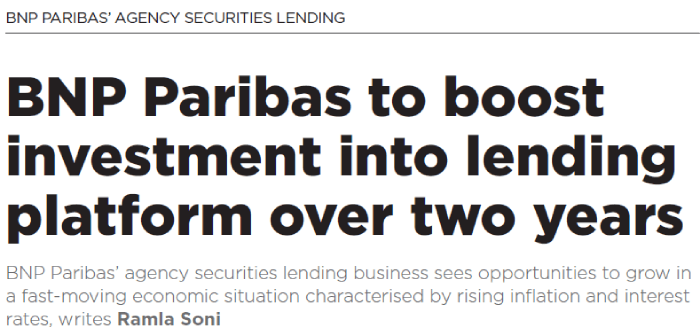BNP Paribas to boost investment in lending platform over two years

BNP Paribas’ agency securities lending business sees opportunities to grow in a fast-moving economic situation characterised by rising inflation and interest rates, says Andrew Geggus, global head of agency securities lending at BNP Paribas Securities Services.
This Thought Leadership article is part of the 2022 Autumn Magazine, which can be accessed here.
BNP Paribas has said its immediate focus is to boost investments in its agency securities lending platform over the next two years, as the French bank continues to focus on delivering a service that helps clients optimise revenue whilst managing risk.
Andrew Geggus, global head of agency securities lending at BNP Paribas Securities Services, told Global Investor the firm has always put clients at the centre of its operations whilst adapting to technological and industry developments.
He said, “With that in mind, we will be increasing our investments into our agency securities lending platform over the next two years, and on top of that, we are setting aside new funds to invest further into our technology, platform and the streamlining of operational processes. The goal is to ensure the product remains market leading and best placed to serve our clients in the foreseeable future. This is an ambitious project that will bring sizeable improvements to our technology platform - allowing for greater automation and efficiency and improving the client experience.”
From a personal perspective, Geggus said his focus lies in helping to develop employees and giving opportunities for personal growth and training.
“When looking at business goals and objectives, employee satisfaction is high on the list. I want to foster a great working environment, offering progression and development opportunities. I have been fortunate in my career to have many layers of supportive management, and this is something we are keen to promote here at BNP Paribas,” he said.
Over the past two years, Geggus believes the securities lending industry has handled the increased volatility very well, demonstrating the strength and resilience of the risk mitigations that have become industry standards.
Geggus, who joined BNP Paribas in 2020 from Northern Trust, said: “Coming out of the global pandemic, there are now further challenges in the form of increased geopolitical instability, inflationary pressures and a rapidly increasing interest rate environment, which has not been seen for many years.
“These challenges also bring about opportunities and I believe we are seeing a new resurgence of interest in securities lending amongst many asset owners and assets managers that potentially are new to the securities lending market, or are re-entering the market having previously exited, highlighting the value seen in being part of this industry. The interest rate environment has also offered a variety of opportunities in the cash space, both from a collateral reinvestment perspective and also clients who are long cash and are looking for their securities finance partner to help them put this cash to work.”
Another industry issue that presents opportunities is the increasing importance of settlement inefficiency, he believes.
“Failed trades exist in the industry, and, whilst firms would prefer they did not, it is the reality of an over-the-counter industry where liquidity and operational efficiency is not guaranteed. The central securities depositories regulation was derived partly due to this issue and there is still plenty of work to be done to increase the settlement efficiency of our industry. This has paved the way for some new and existing providers who are looking at how technology could perhaps be the solution. We are seeing some early adoption of distributed ledger technology and the use of tokenised collateral, which could, in time, overhaul the current settlement system and see a massive improvement in efficiency,” Geggus said.
Geggus sees huge potential in the use of distributed ledger technology in securities lending.
He stated: “The benefits of its theoretical use are clear to see, and, when we start to see the development of the practical use of such technology, I think we will see a rapid improvement in the efficiency of certain processes. Whilst I am a supporter, I also would caution that mass adoption can take time and therefore results may not be seen overnight, but I firmly believe small steps in the right direction can benefit our industry longer term.”
One of the main risks of a lending programme, according to Geggus, is borrower default, that is, where the borrower of the beneficial owner’s securities can no longer facilitate obligations, and defaults whilst still holding the legal title to the beneficial owner’s securities.
He explained, “BNP Paribas utilises three pillars of risk mitigation to help control this risk, the first being counterpart selectivity, internal counterparty ratings and beneficial owner selection means we will only lend to counterparts that BNP Paribas and our beneficial owners have deemed appropriate.
“The second pillar is the collateral. All of the transactions are collateralised including a haircut and are marked to market every day. The last pillar is the indemnification we offer. If there is a short fall in a default scenario, we will indemnify that risk. With indemnification, it is very important to ensure the agent lender offering is credit worthy.”
Other risks include an impact to sale settlement efficiency when recalled securities come in late, he noted.
“This can occur when a security is illiquid and there is no longer availability in the securities lending market to substitute the lent asset. There are tools that agent lenders and beneficial owners can employ to help minimise this risk. A lender can set minimum liquidity thresholds before lending, can look at utilising buffers, can re-rate the borrower to ensure the risk is compensated, and a beneficial owner can look at initiating a buy-in where required."
“These are all aspects an agent lender should be talking about during the on-boarding process with a client to understand their risk appetite and what they see as the main drivers for their securities lending programme,” Geggus added.
Separately, when asset managers are looking to enter a securities lending programme, they need to investigate whether their lender can customise their programme to ensure they are addressing their key criteria for lending, Geggus believes.
“Dependent on the driver of the fund range, or particular regulations the funds must abide by, the agent lender should be able to customise a solution to ensure the asset managers can optimise their revenue within their risk and operational requirements."
“The key is just to be clear on what is important to you as an asset manager and what you are hoping to achieve by entering into securities lending. Your agent lender should then be able to illustrate the different approaches. It is also worth noting this doesn’t have to be one approach for all funds, most agent lenders can cope with a variety of requirements across the full fund range and can adapt their approach accordingly,” he said.
According to Geggus, all asset managers should consider securities lending, although for some it may not be the right time or the right product for them.
“In today’s environment, where yield is hard to come by, I think it is important to understand all options available on the table. I think it is in the best interest of the investors to know that their manager has explored the option of securities lending and in turn looked at whether the additional returns are an appropriate option for that fund range.”
Additionally, Geggus argues that, while often behind the scenes, securities services providers have a key role to play aligning institutional investors and the wider industry with net zero and environmental, social and governance (ESG)-oriented objectives.
He said: “The other important role we play is as partners in these clients’ value chain. By committing to responsible business practices, service providers can help embed long-term sustainability into clients’ operations, minimising risk and maximising positive impact.”
Geggus also views the role of an agent lender within ESG as a partner.
“Given there is a lack of consensus when it comes to ESG, I do not believe a one-size-fits-all solution is what is required. Instead, it is the role of the agent lender to understand from their clients what they see as ESG compliant and put solutions in place to help them achieve this. It is going to be very hard to get a single, unified view and therefore the key is to be adaptable to different needs,” he concluded.
Found this useful?
Take a complimentary trial of the FOW Marketing Intelligence Platform – the comprehensive source of news and analysis across the buy- and sell- side.
Gain access to:
- A single source of in-depth news, insight and analysis across Asset Management, Securities Finance, Custody, Fund Services and Derivatives
- Our interactive database, optimized to enable you to summarise data and build graphs outlining market activity
- Exclusive whitepapers, supplements and industry analysis curated and published by Futures & Options World
- Breaking news, daily and weekly alerts on the markets most relevant to you





